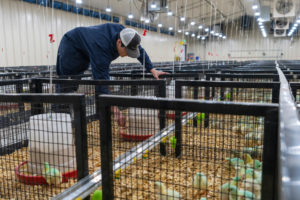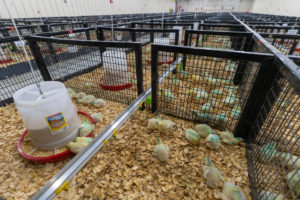Biological Safety Level-II facility first of its kind in nation
New Texas A&M Department of Poultry Science facility to focus on poultry gut health research
Research trials are underway in the new Biological Safety Level-II facility that will focus on intestinal health issues in poultry.

The facility is located in the Texas A&M College of Agriculture and Life Sciences Department of Poultry Science. The on-campus laboratory is part of an ongoing effort to enhance the research, extension and educational capacity of the Department of Poultry Science. Research from the facility will benefit the field of poultry science and the commercial poultry industry.
Merck Animal Health and Tyson Foods provided a $500,000 gift that was matched by the Texas A&M College of Agriculture and Life Sciences to build a new research facility. It is the only Biological Safety Level-II facility of its kind in the U.S.
“This facility helps us to address the most pressing challenges in the poultry industry with applied research,” said Audrey McElroy, Ph.D., head of the Department of Poultry Sciences. “It also allows us to fulfill the land-grant mission, because it is in partnership with our stakeholders in the poultry industry and provides unique research, teaching and extension opportunities through our department.”
New facility adds research capacity, capability
McElroy said nutrition-based research trials are essential to commercial poultry as the industry moves away from the use of antibiotics in response to consumer demand. Intestinal health is critical for bird health, welfare and performance as they digest and absorb food nutrients.
The Texas poultry industry contributes around $4 billion per year to the state’s economy and consumers spend $95 billion a year on poultry in the U.S.
McElroy said the investment in the state-of-the-art facility will ensure Texas A&M spearheads research in poultry disease management at a critical time for the industry.
The facility gives researchers more capacity, with 120 floor pens, providing the ability to replicate more experimental treatments in every six-week broiler grow cycle, McElroy said. Researchers will be able to perform six six-week grow trials per year, with research priorities for Merck and Tyson addressed in three of those trials.
The facility is fitted with technology, including advanced system ventilation, and follows biosecurity protocols that allow researchers to test dietary impacts on disease challenges commercial producers face.
“The advantage of this facility is that it allows us to perform real-world floor-pen evaluations of intestinal health in nutritional trials with disease challenges,” she said. “These dietary studies require a lot of replications in order to identify differences, because they may be very small nutritional changes or a dietary supplement that you see translate to performance in terms of body weight or feed conversion.”
The industry has shifted away from antibiotics to natural alternatives like prebiotics, probiotics, phytogenics and nutraceuticals, McElroy said. Intestinal bacteria and parasites, including coccidia and clostridium, represent major losses for producers in terms of weight gains and flock performance.
Researchers will also be able to study salmonella and campylobacter, which are two of the most prevalent food safety concerns for poultry product consumers, McElroy said.
“The research has crossover potential,” she said. “The poultry industry loses millions of dollars each year in feed conversion and production costs because of coccidia, but it has no impact on human health. And while salmonella doesn’t impact bird health, it has huge implications for human health. So, it allows us to address both bird and human health, which is something we haven’t been able to do on this scale before.”
Infrastructure, research attractive to students, faculty

McElroy said the cutting-edge facility also represents a recruiting tool for both faculty and students.
The facility will provide teaching opportunities for undergraduate and graduate students to receive hands-on instruction in a production environment that uses equipment and technology already being applied in the industry.
“It has all new equipment in terms of electronic controller systems for environmental management that students will see in the field,” she said. “So, it will allow our undergraduate students to learn about poultry management and graduate students to run research trials.”
The cutting-edge research opportunities and facility infrastructure will also be attractive to top researchers for the department, which is currently seeking a tenure-track assistant professor for sustainable technologies in poultry production.
McElroy said the facility is likely to attract more public and private investment in the department to support research, teaching and extension programming.
“This facility is a partnership with industry that benefits everyone, from producers to consumers,” she said. “The research done here makes Texas A&M unique, because we are capable of studying the most cutting-edge aspect of poultry disease management.”


